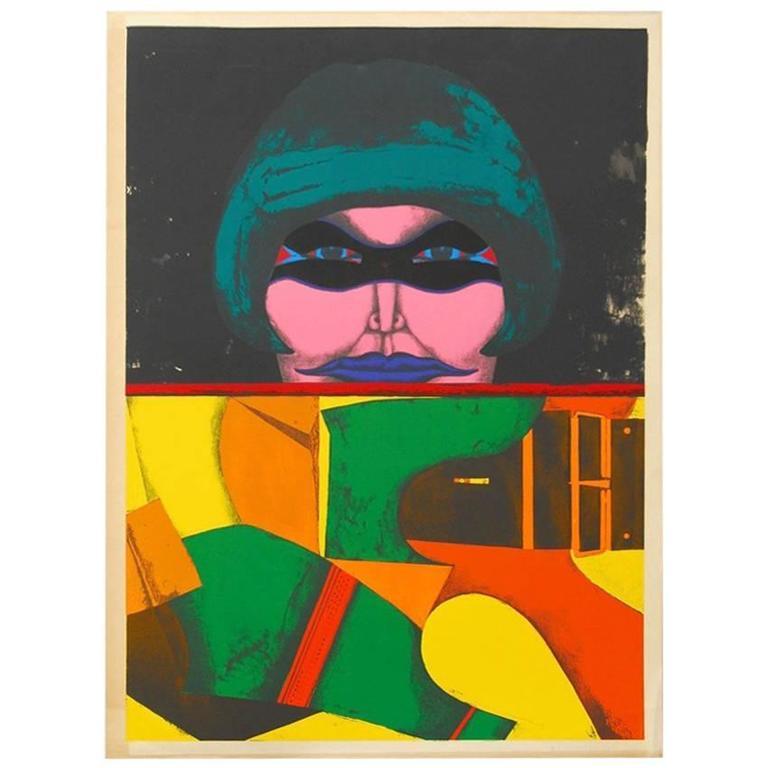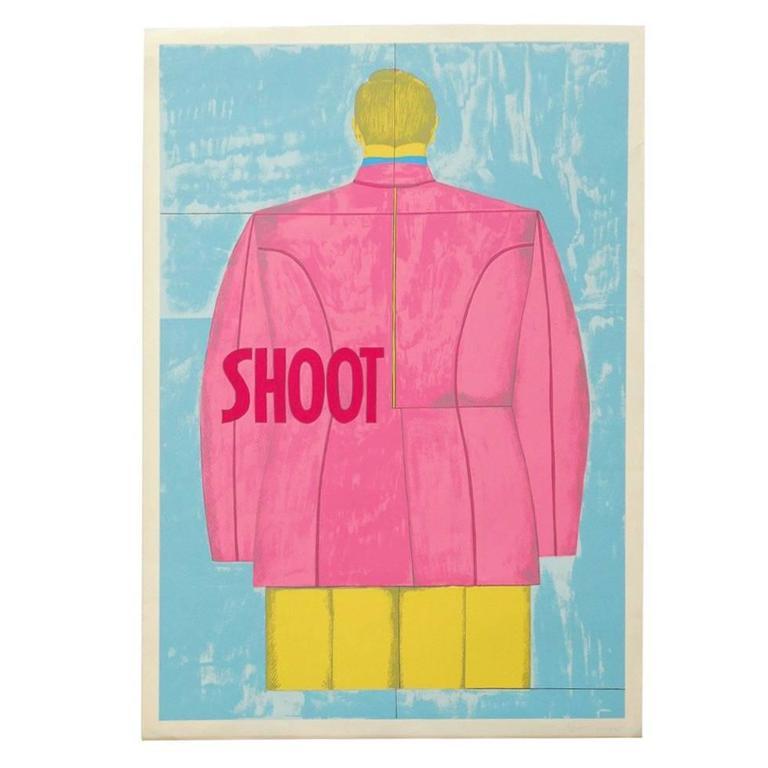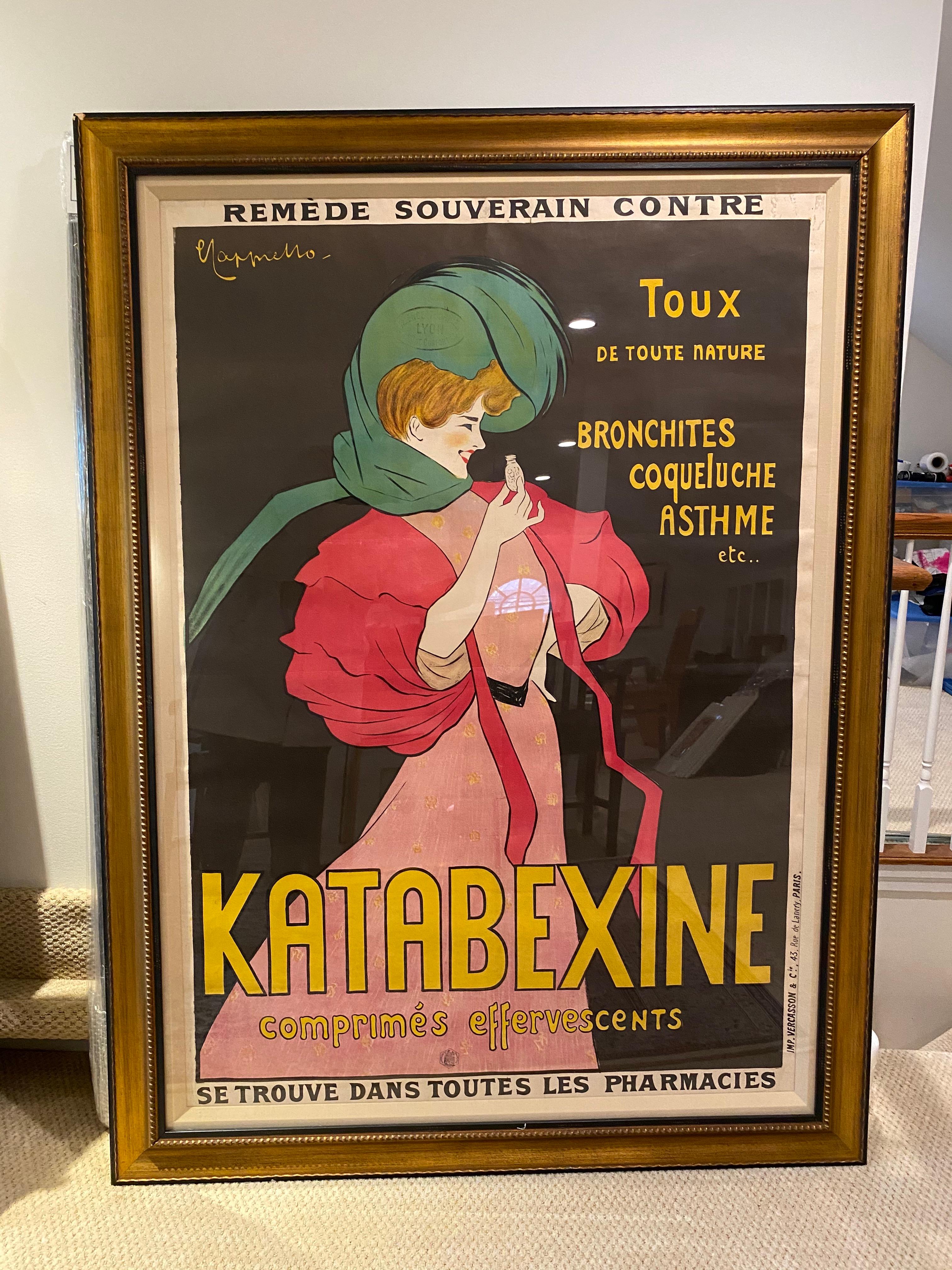Items Similar to "La Visite des Amateurs, " Original Color Lithograph signed by Claude Weusbuch
Want more images or videos?
Request additional images or videos from the seller
1 of 9
Claude Weisbuch"La Visite des Amateurs, " Original Color Lithograph signed by Claude Weusbuch 1973
1973
About the Item
"La Visite des Amateurs" is an original color lithograph by Claude Weisbuch. It is signed in the lower right and editioned "EA" in the lower left. This piece depicts four figures: one artist in black robes, two onlookers, and one female nude model. They appear to be in an endless flat landscape.
22" x 29 7/8" art
Claude Weisbuch was born on February 8th, 1927 in Thionville, France. His art includes drawing, painting and lithographs. Inventive and unique with his style he uses color range that is warm and rich in tone, certainly equal to that of Rembrandt. The fluidity of line and creation of motion is even more vigorous that in the work of Daumier or Toulouse Lautrec. His creativeness in composition is awesome and seems to have infinite possibilities of variation and vision. Weisbuch died in 2014.
Exhibitions
Herve Odermatt Gallery Paris, France
Escole de Paris Paris, France
David Barnett Gallery Milwaukee,Wisconsin
Education
Ecole des Beaux-Arts de Nancy Nancy, France
- Creator:Claude Weisbuch (1927, French)
- Creation Year:1973
- Dimensions:Height: 22 in (55.88 cm)Width: 29.875 in (75.89 cm)
- Medium:
- Period:
- Condition:
- Gallery Location:Milwaukee, WI
- Reference Number:
About the Seller
4.9
Platinum Seller
These expertly vetted sellers are 1stDibs' most experienced sellers and are rated highest by our customers.
Established in 1966
1stDibs seller since 2017
388 sales on 1stDibs
Typical response time: 1 hour
- ShippingRetrieving quote...Ships From: Milwaukee, WI
- Return PolicyA return for this item may be initiated within 14 days of delivery.
More From This SellerView All
- "Le Bouquet tout fait (The Ready-made Bouquet), " Lithograph after Rene MagritteBy René MagritteLocated in Milwaukee, WI"Le Bouquet tout fait (The Ready-made Bouquet)" is a color lithograph after a 1954 original painting by Rene Magritte. A bourgeois "little man" faces away from the viewer looking towards a fall forest. Flora, the goddess of flowers and season of spring, from Sandro Botticelli's "Primavera" is painted on the back of the man. This juxtaposes fall and spring. Art: 12 x 9.75 in Frame: 22.38 x 20.38 in René-François-Ghislain Magritte was born November 21, 1898, in Lessines, Belgium and died on August 15, 1967 in Brussels. He is one of the most important surrealist artists. Through his art, Magritte creates humor and mystery with juxtapositions and shocking irregularities. Some of his hallmark motifs include the bourgeois “little man,” bowler hats, apples, hidden faces, and contradictory texts. René Magritte’s father was a tailor and his mother was a miller. Tragedy struck Magritte’s life when his mother committed suicide when he was only fourteen. Magritte and his two brothers were thereafter raised by their grandmother. Magritte studied at the Brussels Academy of Fine Arts from 1916 to 1918. After graduating he worked as a wallpaper designer and in advertisement. It was during this period that he married Georgette Berger, whom he had known since they were teenagers. In 1926, René Magritte signed a contract with the Brussels Art Gallery, which allowed him to quit his other jobs and focus completely on creating art. A year later he had his first solo show at the Galerie la Centaurie in Brussels. At this show Magritte exhibited what is today thought of as his first surrealist piece, The Lost Jockey, painted in 1926. In this work a jockey and his steed run across a theater stage, curtains parted on either side. Throughout the scene, there are trees with trunks shaped somewhat like chess pawns with musical scores running vertically up their sides and branches sticking out from all angles. Critics did not enjoy this style of art; it was new, different, and took critical thought to understand, but The Lost Jockey was only the first of many surrealist artworks Magritte would paint. Because of the bad press in Brussels, René and Georgette moved to Paris in 1927, with the hope that this center of avant-garde art would bring him success and recognition. In Paris, he was able to become friends with many other surrealists, including André Breton and Paul Éluard. They were able to learn from and inspire one another, pushing the Surrealist movement further forward. It was also in Paris that Magritte decided to add text to some of his pieces, which was one of the elements that made his artwork stand out. In 1929, he painted one of his most famous oil works: The Treachery of Images. This is the eye-catching piece centered on a pipe. Below the pipe is written “Ceci n’est pas un pipe,” which translates to “This is not a pipe.” This simple sentence upset many critics of the time, for of course it was a pipe. Magritte replied that it was not a pipe, but a representation of a pipe. One could not use this oil on canvas as a pipe, to fill it with tobacco and smoke it. Thus, it was not a pipe. In 1930, Magritte and Georgette moved back to Brussels. Though they would travel to his exhibitions elsewhere, their home going forward would always be in Brussels. Magritte had his first American exhibition at the Julien Levy Gallery in New York City in 1936 and his first show in England two years later in 1938 at The London...Category
2010s Surrealist Figurative Prints
MaterialsLithograph
- "La Reconnaissance Infinie (The Infinite Recognition)" Litho after Rene MagritteBy René MagritteLocated in Milwaukee, WI"La Reconnaissance Infinie (The Infinite Recognition)" is a color lithograph after the 1963 painting by Rene Magritte. Two of Magritte's bourgeois "little men" stand in the sky. Both look away from the viewer talking to each other in the typical outfit of Magritte's men, black trench coats and bowler hats. Art: 15 x 18.25 in Frame: 26.25 x 29.88 in René-François-Ghislain Magritte was born November 21, 1898, in Lessines, Belgium and died on August 15, 1967 in Brussels. He is one of the most important surrealist artists. Through his art, Magritte creates humor and mystery with juxtapositions and shocking irregularities. Some of his hallmark motifs include the bourgeois “little man,” bowler hats, apples, hidden faces, and contradictory texts. René Magritte’s father was a tailor and his mother was a miller. Tragedy struck Magritte’s life when his mother committed suicide when he was only fourteen. Magritte and his two brothers were thereafter raised by their grandmother. Magritte studied at the Brussels Academy of Fine Arts from 1916 to 1918. After graduating he worked as a wallpaper designer and in advertisement. It was during this period that he married Georgette Berger, whom he had known since they were teenagers. In 1926, René Magritte signed a contract with the Brussels Art Gallery, which allowed him to quit his other jobs and focus completely on creating art. A year later he had his first solo show at the Galerie la Centaurie in Brussels. At this show Magritte exhibited what is today thought of as his first surrealist piece, The Lost Jockey, painted in 1926. In this work a jockey and his steed run across a theater stage, curtains parted on either side. Throughout the scene, there are trees with trunks shaped somewhat like chess pawns with musical scores running vertically up their sides and branches sticking out from all angles. Critics did not enjoy this style of art; it was new, different, and took critical thought to understand, but The Lost Jockey was only the first of many surrealist artworks Magritte would paint. Because of the bad press in Brussels, René and Georgette moved to Paris in 1927, with the hope that this center of avant-garde art would bring him success and recognition. In Paris, he was able to become friends with many other surrealists, including André Breton and Paul Éluard. They were able to learn from and inspire one another, pushing the Surrealist movement further forward. It was also in Paris that Magritte decided to add text to some of his pieces, which was one of the elements that made his artwork stand out. In 1929, he painted one of his most famous oil works: The Treachery of Images. This is the eye-catching piece centered on a pipe. Below the pipe is written “Ceci n’est pas un pipe,” which translates to “This is not a pipe.” This simple sentence upset many critics of the time, for of course it was a pipe. Magritte replied that it was not a pipe, but a representation of a pipe. One could not use this oil on canvas as a pipe, to fill it with tobacco and smoke it. Thus, it was not a pipe. In 1930, Magritte and Georgette moved back to Brussels. Though they would travel to his exhibitions elsewhere, their home going forward would always be in Brussels. Magritte had his first American exhibition at the Julien Levy Gallery in New York City in 1936 and his first show in England two years later in 1938 at The London Gallery...Category
2010s Surrealist Figurative Prints
MaterialsLithograph
- Homage a Leonardo d' Vinci (Three Figures Advancing from De La Bataille Vol. I)By Claude WeisbuchLocated in Milwaukee, WIArt: 17" x 23 1/4" Frame: 27 5/8" x 33 7/8" Original color lithograph (VIII/L) Signed lower right. This original Weisbuch lithograph comes from th...Category
1970s Contemporary Figurative Prints
MaterialsLithograph
- "Annette, " by Alberto GiacomettiBy Alberto GiacomettiLocated in Milwaukee, WI"Annette" is an original black and white lithograph by Alberto Giacometti. It depicts the bust of a nude woman in scratchy lines. Annette was Alberto's wife and frequently modeled fo...Category
1960s Minimalist Figurative Prints
MaterialsLithograph
- "Family of Six, " Original Lithograph signed by John Thomas BiggersBy John Thomas BiggersLocated in Milwaukee, WI"Family of Six" is an original black and white lithograph by John Biggers. The artist signed and dated the piece in the lower right and titled and editioned it (AP III) in the lower ...Category
1980s Contemporary Figurative Prints
MaterialsLithograph
- Original Lithograph Native American Figure Portrait Male Tribe Bold Stoic SignedBy Leonard BaskinLocated in Milwaukee, WI"Kill Spotted Horse" is an original lithograph created by Leonard Baskin. It was published by Fox Graphics. This is a proof purchased directly from the artist. Baskin signed the work in the lower right margin and labelled the work as a proof in the lower left margin, written with graphite. It depicts Kill Spotted Horse, an Assinniboine Native American, in a feather headdress against a light blue background. Artwork Size: 15" x 13 1/2" Frame Size: 27 1/2" x 26 3/8" Artist Bio: Leonard Baskin (1922-2000) was an american artist born in New Jersey and taught art classes in Massachusetts. He has received many public commissions (including a bas relief for the FDR Memorial), honors, and his work is owned by many major museums around the world. Additionally, Baskin was a teacher at Smith College in Northampton, Massachusetts. As a champion for human rights, Baskin created many pieces celebrating those who were seldom recognized. Baskin’s interest in nineteenth century Native Americans was roused into acute attendance from ignorant indifference, when the National Park Service asked him to provide illustrations for the handbook that described the then called “Custer National Park”, now called “Little Big...Category
1990s Contemporary Portrait Prints
MaterialsLithograph, Ink
You May Also Like
- "Little Harvest Mouse": A Framed Original Audubon Hand-colored Folio LithographBy John James AudubonLocated in Alamo, CAThis rare original first edition Audubon hand-colored imperial folio-sized lithograph entitled "Mud Minimus Aud and Bach, Little Harvest Mouse, Males and Females, Natural Size" was e...Category
Mid-19th Century Naturalistic Animal Prints
MaterialsLithograph
- Original 19th C. Vanity Fair Caricature of "An Old Fashioned Judge", Henry LopesBy Sir Leslie WardLocated in Alamo, CAA framed hand-colored Vanity Fair caricature of a prominent 19th century English judge, Henry Charles Lopes, 1st Baron Ludlow (1828-1899) entitled "An O...Category
1890s Victorian Portrait Prints
MaterialsLithograph
- Liz F&S II.7By Andy WarholLocated in New York, NY1964 Offset lithograph in colors, on wove paper Sheet: 23 1/8 x 23 1/8 in. Edition of 300 Signed and dated in ballpoint pen, lower right Unframed, pristine conditionCategory
1960s Pop Art Figurative Prints
MaterialsOffset, Paper, Lithograph
- Large Color French Cubist Lithograph Tree of Life Signed Ltd Ed. Sculpture StudyBy Jacques LipchitzLocated in Surfside, FLChaim Jacob Lipchitz, 1891-1973, was born in Lithuania and came of age in Paris during the early 20th century, where he was active in the avante-garde community of Pablo Picasso, Ama...Category
1970s Cubist Figurative Prints
MaterialsLithograph
- Yellow Jacket - XX century, Figurative Lithography PrintBy Waldemar MarszałekLocated in Warsaw, PLWALDEMAR MARSZAŁEK (born in 1960) Polish painter. He received his diploma in graphic design in 1985. He is a professor at the Academy of Fine Arts i...Category
1990s Other Art Style Figurative Prints
MaterialsPaper, Lithograph
- La domaine des murmures. L`après-midi d`été.Located in Warsaw, PLLandscape print by Suzanne PirotteCategory
21st Century and Contemporary Other Art Style Figurative Prints
MaterialsPaper, Lithograph
Recently Viewed
View AllMore Ways To Browse
Equals Signs
Lautrec Original
Toulouse Lautrec Original
Dior White Flats
Toulouse Lautrec Original Print
Vintage Style Robe
Toulouse Lautrec Signed Lithograph
Original Lithograph Lautrec
Original Toulouse Lautrec Lithograph
Ea France
Rembrandt Lithograph
Daumier Lithographs
Lithograph 7 Nudes
Robe Vintage Dior
Robe Dior Vintage
Retro Dior Robe
Weisbuch Claude
Original Lithograph Rembrandt



